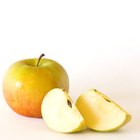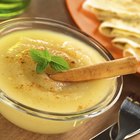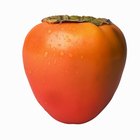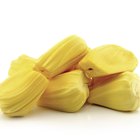
Applesauce isn't just for baby food. Whether cooked or simply pureed, applesauce has a smooth texture and rich taste that complements a variety of dishes. While you may be tempted to grab a jar from the grocery store shelves, making it from scratch is easier than you might think, and it allows you to control what other ingredients go into it.
Preparation
The easiest way to prepare applesauce is to peel the apple, cut it into wedges and cook it over low heat on the stove or in a slow cooker with a little bit of water until the apple flesh breaks down into a thick, smooth mixture. You can also cut the apple into small pieces and puree it in a blender with a small amount of liquid. If prepared this way, it is not necessary to cook the applesauce. Since cooked apples contain more cholesterol-lowering pectin, however, you may opt to cook the pureed apples for a short time.You can also get more pectin into your raw, pureed sauce by using unpeeled apples, because the apple's skin contains more pectin than the flesh.
Apple Varieties
The most important part of making a good applesauce is choosing the right apples. Apples with a very firm flesh, such as the Fuji variety, may require a longer cooking time. These are not the best choice if you plan to puree the raw apples unless you have a heavy-duty blender. Softer apples, such as McIntosh, are better suited for a raw, pureed sauce, but these types of apples usually produce a thinner applesauce when cooked. If you choose apples with a tart flavor, such as a Granny Smith, you may need to add sugar to the sauce to tone down the tartness. Sweeter apples, such as Golden Delicious, may require the addition of lemon juice to balance out the sweetness. If you want to avoid adding extra ingredients, use a mixture of sweet and tart apples.
Make Your Own Blend
Lend your own unique touch to applesauce by adding in some basic spices. Nutmeg, cloves, cinnamon and allspice complement the flavor of apples, and they give complexity of flavor to the finished sauce. If you only want subtle notes of the spice, add a whole cinnamon stick or vanilla bean to the applesauce while it is cooking, and remove it before serving. Experiment with adding other types of fruits to the applesauce. Children might not appreciate the tartness of cranberries, but pears, peaches and strawberries are all good kid-friendly choices. For a little more texture, add raspberries, raisins or blueberries to the sauce after cooking or pureeing.
Creative Uses for Applesauce
Although applesauce is often simply eaten out of a bowl, there are plenty of creative uses for it in the kitchen. Serve it as a side dish with a pork roast, add some to to your next batch of cookie dough or cake batter or use it to sweeten your morning oatmeal. For a satisfying cold-weather dessert, put a few inches of applesauce in your slow cooker and top it with gingerbread batter. When the cake finishes cooking, serve the cake and sauce in a bowl topped with fresh whipped cream.
Related Articles
How to Thicken Applesauce

How to Make Plum Sauce

How to Cook Strawberries

How to Rehydrate Dried Apple Slices

How Many Calories in Applesauce?

Substitute for Framboise Liqueur

How to Make a Grapefruit Facial Mask

How to Juice Kiwi Fruit

How to Make a Yogurt Smoothie

How to Make Natural Pectin From Lemons

How to Cook Papaya

Tips on Preparing and Cooking ...

How to Make Mango Preserves

How to Make Old Fashioned Apple Jelly

What Can You Do With Fresh Persimmons?

Types of Fruit Smoothies

How to Make Melon Ice Cream

Rolled Oats vs. Quick Oats for Apple ...

Can I Boil a Pear to Soften It?

How to Make a Jackfruit Shake With Milk
References
Resources
Writer Bio
After attending Fairfield University, Hannah Wickford spent more than 15 years in market research and marketing in the consumer packaged goods industry. In 2003 she decided to shift careers and now maintains three successful food-related blogs and writes online articles, website copy and newsletters for multiple clients.
Photo Credits
Brand X Pictures/Brand X Pictures/Getty Images